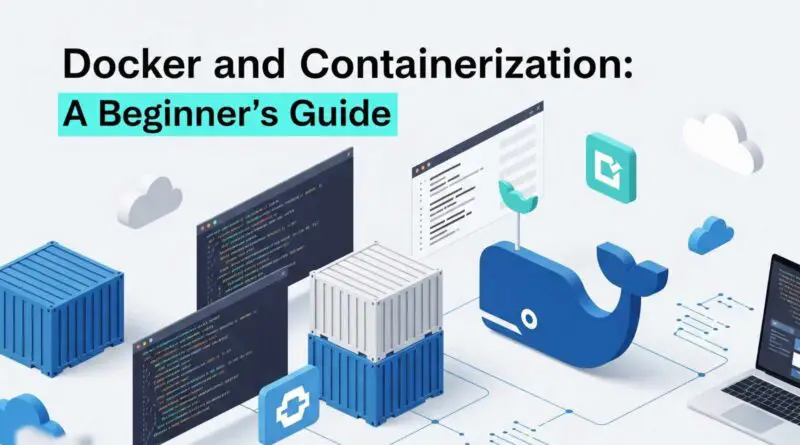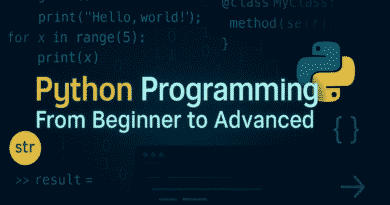Docker and Containerization: A Beginner’s Guide
Docker and Containerization: A Beginner’s Guide to Efficient Software Deployment
📦 What is Docker? Introduction to Containers
In the fast-paced world of software development, consistency and efficiency are key. Docker is a powerful platform designed to meet these needs by using a method known as containerization. But before we dive deeper, let’s break it down in simple terms.
What is Docker?
Docker is an open-source platform that simplifies the process of building, running, and managing applications through containers. Think of Docker as a tool that lets developers package up an application with everything it needs—code, runtime, libraries, and dependencies—and ship it all as one single unit.
What Are Containers?
Containers are lightweight, standalone, and executable packages of software. Unlike virtual machines, containers share the host system’s OS kernel but run in isolated processes. This makes them faster and more efficient.
Benefits of Docker:
- Consistency across environments: From development to production, the environment stays the same.
- Efficiency: Containers are lightweight and start quickly.
- Scalability: Easily scale applications across cloud or local environments.
- Portability: Run containers on any system that has Docker installed.
Real-World Example:
Let’s say a developer builds a web app on their laptop with Python, Flask, and a specific version of PostgreSQL. Without containers, they’d need to manually install and configure these on every server the app is deployed to. With Docker, everything can be containerized and run on any environment without reconfiguration.
Also Read,
| DevOps Fundamentals (Beginner – No Experience Needed) |
🐳 Installing and Running Your First Docker Container
Getting started with Docker is easier than you might think. Here’s a comprehensive guide to set up Docker and run your first container:
Step 1: Install Docker
- Windows & macOS:
- Download Docker Desktop from docker.com.
- Follow the installation instructions.
- Linux (Ubuntu):
1234sudo apt updatesudo apt install docker.iosudo systemctl start dockersudo systemctl enable docker
Step 2: Verify Docker Installation
Run the following command:
|
1 |
docker --version |
This confirms Docker is installed.
Step 3: Run Your First Docker Container
|
1 |
docker run hello-world |
This command pulls a test image from Docker Hub and runs it in a container. You should see a welcome message confirming that Docker is working correctly.
Real-World Example:
If you’re learning Node.js, you could run:
|
1 |
docker run -it node |
This gives you an interactive Node.js shell within a containerized environment.
📁 Dockerfile Explained – Build Custom Images
A Dockerfile is a simple text file that contains instructions to build a Docker image. Images are the blueprints of containers.
Basic Dockerfile Example:
|
1 2 3 4 5 6 7 8 9 10 11 12 13 14 15 16 17 18 19 20 |
# Use official Python image FROM python:3.9 # Set the working directory inside the container WORKDIR /app # Copy current directory contents into the container COPY . /app # Install Python dependencies RUN pip install -r requirements.txt # Make port 80 available EXPOSE 80 # Define environment variable ENV NAME World # Run the application CMD ["python", "app.py"] |
Explanation of Each Command:
- FROM: Sets the base image.
- WORKDIR: Defines the working directory.
- COPY: Copies local files into the container.
- RUN: Executes a command during the build (like installing packages).
- EXPOSE: Opens a port.
- ENV: Sets environment variables.
- CMD: Specifies what to run when the container starts.
Real-World Example:
Let’s say you’re building a REST API with Flask. You can write a Dockerfile as above, and every time you build the image with docker build -t flask-api ., it creates a portable image ready to deploy anywhere.
🔗 Docker Compose – Multi-Container Applications
Applications often rely on multiple services like databases, caches, etc. Docker Compose helps manage these by defining them in a docker-compose.yml file.
Sample docker-compose.yml:
|
1 2 3 4 5 6 7 8 9 10 11 12 13 14 15 16 |
version: '3' services: web: build: . ports: - "5000:5000" volumes: - .:/code depends_on: - db db: image: postgres environment: POSTGRES_USER: user POSTGRES_PASSWORD: pass |
How It Works:
webis your application.dbis the PostgreSQL database.depends_onensures the database starts before the web app.
Benefits:
- Manage multiple containers with one command.
- Define entire application stacks in a single file.
- Simplifies development and testing.
Real-World Example:
You’re building an e-commerce site with a frontend, backend, and a database. Docker Compose allows you to run all three services with docker-compose up, saving you from starting each manually.
📦 Image Registries: Docker Hub, JFrog Artifactory, Harbor
Once you’ve built a Docker image, you’ll likely want to store or share it. This is where image registries come in.
Docker Hub
- Most popular public registry.
- Hosts thousands of official and community-contributed images.
- You can push your custom images by tagging and running:
|
1 2 |
docker tag myimage username/myimage docker push username/myimage |
JFrog Artifactory
- Enterprise-level solution.
- Supports Docker and other binary repositories (Maven, npm, etc.).
- Offers features like access control, metadata, and integration with CI/CD pipelines.
Harbor
- Open-source, cloud-native registry by VMware.
- Provides advanced security, RBAC, image scanning, and auditing.
- Ideal for enterprises with compliance requirements.
Real-World Example:
A development team creates a CI/CD pipeline that builds a new Docker image on each push to GitHub. This image is automatically pushed to Harbor, where it’s scanned for vulnerabilities before being deployed to Kubernetes.
Conclusion
Docker and containerization offer transformative benefits for developers, system admins, and students alike. From simplifying the development workflow to making deployments reliable and repeatable, Docker is a must-learn tool in today’s software landscape.
By mastering Docker, Dockerfile, Docker Compose, and registries like Docker Hub and Harbor, you can streamline your development and deployment processes, whether you’re building a simple web app or managing complex microservices.
📤 Stay Updated with NextGen Careers Hub
📱 Follow us on Instagram
📺 Subscribe us on YouTube
Please share our website with others: NextGenCareersHub.in






Pingback: 🚀 Must-Have VS Code Extensions Every Developer Should Use in 2025 - Telugu Careers Hub